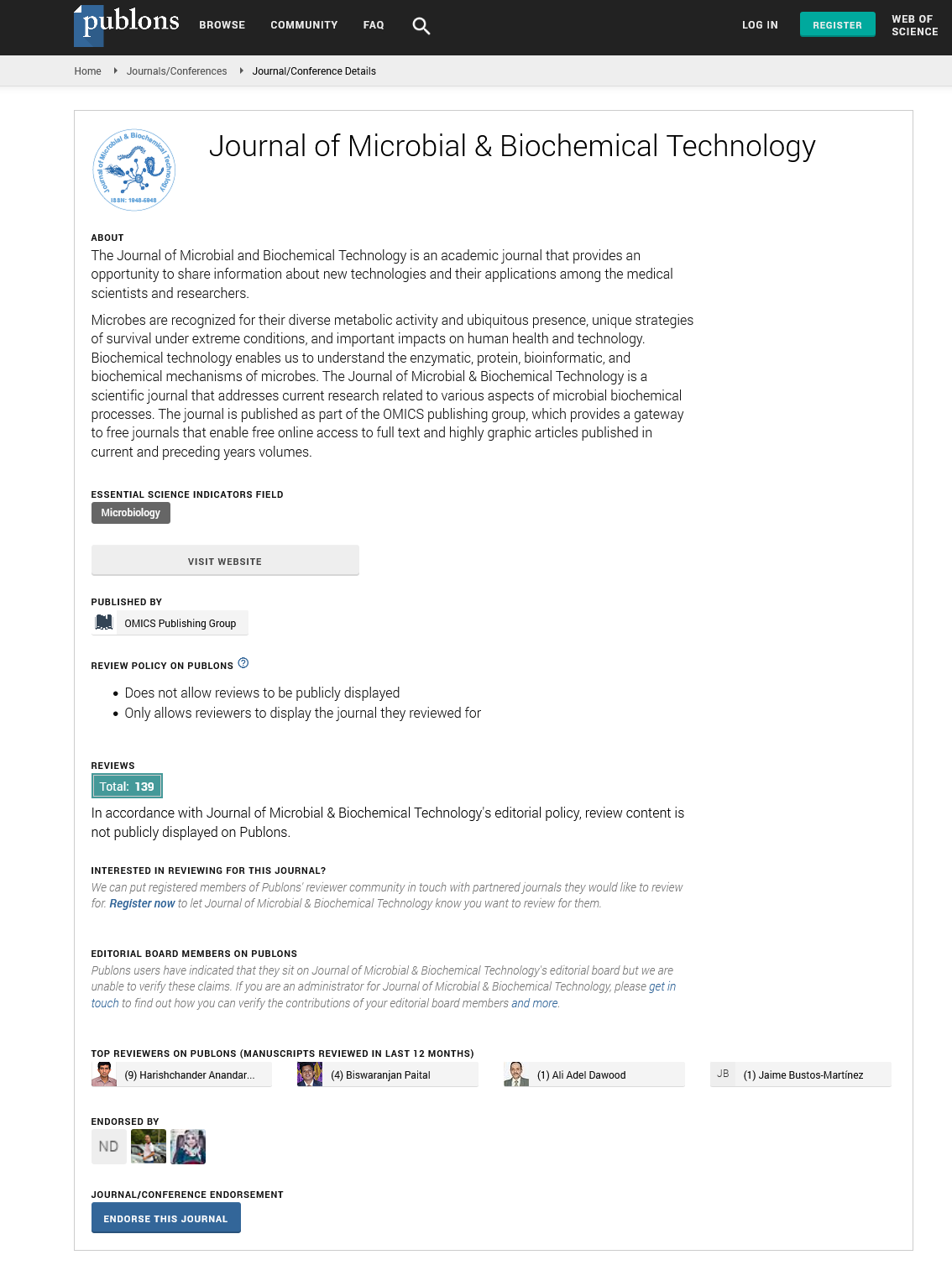Indexed In
- Academic Journals Database
- Genamics JournalSeek
- Academic Keys
- JournalTOCs
- China National Knowledge Infrastructure (CNKI)
- Scimago
- Access to Global Online Research in Agriculture (AGORA)
- Electronic Journals Library
- RefSeek
- Directory of Research Journal Indexing (DRJI)
- Hamdard University
- EBSCO A-Z
- OCLC- WorldCat
- SWB online catalog
- Virtual Library of Biology (vifabio)
- Publons
- MIAR
- University Grants Commission
- Geneva Foundation for Medical Education and Research
- Euro Pub
- Google Scholar
Useful Links
Share This Page
Journal Flyer

Open Access Journals
- Agri and Aquaculture
- Biochemistry
- Bioinformatics & Systems Biology
- Business & Management
- Chemistry
- Clinical Sciences
- Engineering
- Food & Nutrition
- General Science
- Genetics & Molecular Biology
- Immunology & Microbiology
- Medical Sciences
- Neuroscience & Psychology
- Nursing & Health Care
- Pharmaceutical Sciences
Opinion Article - (2025) Volume 17, Issue 2
Microbial Bioremediation of Heavy Metal Contamination
Emily Johnson*Received: 01-May-2025, Manuscript No. JMBT-25-29611; Editor assigned: 03-May-2025, Pre QC No. JMBT-25-29611; Reviewed: 16-May-2025, QC No. JMBT-25-29611; Revised: 21-May-2025, Manuscript No. JMBT-25-29611; Published: 28-May-2025, DOI: 10.35248/1948-5948.25.17.648
Description
Heavy metal contamination presents serious threats to both environmental and human health due to the persistent and toxic nature of these pollutants. Unlike organic contaminants, heavy metals do not degrade over time and can accumulate in living organisms, disrupting ecosystems and causing long-term damage. In response to this global issue, microbial bioremediation has emerged as a promising and environmentally sustainable alternative to traditional remediation methods. This approach uses bacteria, fungi and algae to detoxify, immobilize or transform heavy metals into less harmful forms. As it avoids the high costs and environmental disruption associated with physical or chemical treatments, microbial bioremediation is gaining traction for in-situ applications across diverse contaminated environments. By harnessing the natural metabolic capabilities of microorganisms, this technique provides a more ecologically balanced solution for remediating polluted sites without introducing additional chemicals or waste.
Microorganisms interact with heavy metals through various biochemical and physical mechanisms, each contributing to the detoxification or removal of toxic elements from the environment. Among these, bio sorption is one of the most widely studied processes, where microbial cell walls rich in functional groups such as carboxyl, hydroxyl and phosphate bind metal ions through passive adsorption. This method is rapid, reversible and applicable to a broad spectrum of metals including lead, cadmium and mercury. In contrast, bioaccumulation involves the active transport of metal ions into microbial cells, where the metals are either stored or biochemically altered into less toxic compounds. Certain fungi such as Aspergillus and Penicillium exhibit notable bioaccumulation capacities and have shown effectiveness in laboratory and field-scale remediation efforts. Algae, especially in aquatic environments, contribute significantly by accumulating heavy metals from water bodies, playing a vital role in large-scale bioremediation. Another key process is enzymatic reduction, wherein microbes use reductase enzymes to convert metals into less soluble and less bioavailable forms, effectively lowering their toxicity and environmental mobility.
A well-documented example of enzymatic reduction in microbial remediation is the transformation of Hexavalent Chromium (Cr(VI)) a known carcinogen into its trivalent form which is considerably less toxic and more stable. Microbial strains such as Pseudomonas and Bacillus have demonstrated remarkable capacity in carrying out this conversion under various environmental conditions. Their effectiveness highlights the potential for microbial-based approaches in treating highly contaminated industrial sites. However, the success of microbial remediation is closely tied to environmental factors including pH, temperature, metal concentration and nutrient availability. When natural conditions are not conducive to microbial activity, enhancement techniques such as bio stimulation and bio augmentation are employed. Bio stimulation involves adding nutrients or electron donors to stimulate indigenous microbial populations, whereas bio augmentation introduces specific strains known for their high remediation efficiency. Both strategies aim to accelerate the clean-up process and ensure consistent performance across diverse environmental conditions.
In recent years, the integration of microbial technologies with nanomaterials has further enhanced the potential of bioremediation. Bio nanocomposites, which combine microbes with nanoparticles, can significantly increase metal binding capacities and stability of the remediation process. These hybrid systems offer new possibilities for treating complex contamination scenarios where conventional methods fall short. Despite these advances, the application of microbial remediation in real-world settings continues to face challenges. Variability in soil and water chemistry, competition among microbial species and uncertainties around the long-term stability of remediation outcomes remain significant hurdles. Continued research on microbial consortia groups of different microorganisms working synergistically and genetically engineered strains is helping to improve adaptability and resilience in diverse environments. With technological improvements and a deeper understanding of microbial ecology and metal-microbe interactions, microbial bioremediation is poised to become a key component of sustainable environmental management. As global awareness of pollution and environmental degradation increases, these biological systems offer a powerful, low-impact solution for restoring ecological balance and safeguarding public health
Heavy metal pollution is a serious environmental concern due to its toxicity and persistence. Microbial bioremediation offers a sustainable and eco-friendly solution by using bacteria, fungi and algae to detoxify or immobilize these pollutants. Microorganisms interact with metals through processes like bio sorption, bioaccumulation and enzymatic reduction. Techniques such as bio stimulation and bio augmentation enhance microbial efficiency, while recent advances in bio nanotechnology improve metal removal rates. Despite some challenges in field applications, ongoing research into microbial consortia and engineered strains is improving effectiveness. This green technology holds great promise for restoring contaminated environments.
Citation: Johnson E (2025). Microbial Bioremediation of Heavy Metal Contamination. 17:648.
Copyright: © 2025 Johnson E. This is an open-access article distributed under the terms of the Creative Commons Attribution License, which permits unrestricted use, distribution and reproduction in any medium, provided the original author and source are credited.

